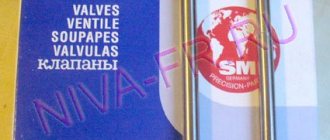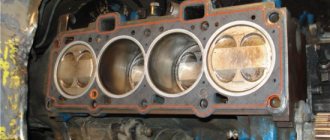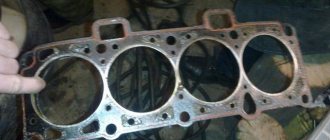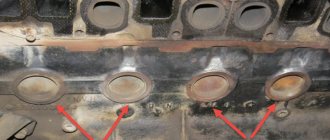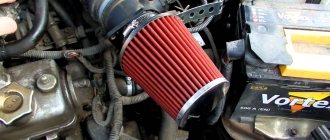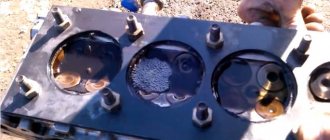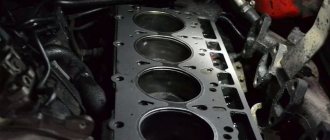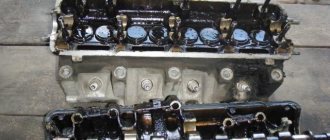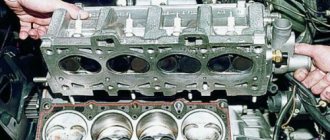06/19/2018 Category: Auto repair and maintenance Author: admin
The cylinder head is a one-piece engine housing part to which all components of the unit are attached. It unites all cylinders. The crankshaft is attached to the bases located on it. The head is fixed at the top, and the crankcase is fixed at the bottom. The cylinders operate under extreme conditions - gases heated to 1500 degrees move inside, and the rings slide along its walls at enormous speed, subjecting them to strong frictional forces. Naturally, it must be made of durable material.
Most often, gray cast iron, aluminum and magnesium hard alloys are used for this. The surfaces of the cylinder block (bearing bed, connection areas with the block, bore for liners and the surface itself) must be perfectly processed. Even microscopic deviations lead, in the future, to oil leakage from under the cylinder head.
- 1 Why does oil leak from under the cylinder head?
- 2 Types of damage to the cylinder head gasket. What will they affect?
- 3 Eliminating leaks from under the cylinder head
The essence of the breakdown
As we said earlier, there is a sealing element between the head and the block.
- Poorly tightened bolts. This usually occurs due to poor quality repairs.
- Deformation of the gasket itself (unfortunately, no one is immune from defects).
It is not always the gasket that causes an oil leak from under the cylinder head. Reason #2 is engine overheating. As a result, the surface of the cylinder head becomes uneven. Even after replacing the sealing element, oil leakage from under the cylinder head does not stop. It is necessary to grind the cylinder head or replace it with a new one. The latter option is often applied to heads that have cracks. There is no way to repair them. The structure has already lost its strength and tightness.
Installation
After removing the old gasket, prepare the surface. How to do it? We clean the surface of the block from dirt (and remnants of the old gasket, if any), and thoroughly degrease it.
The same goes for the area on the head. Both mating surfaces must be extremely dry and clean. Next, the gasket itself is installed. It is important to prevent it from moving relative to the mounting holes. The oil passage hole should be between the third and fourth cylinders. The sealant has already been applied to the surface of the sealing element. There is no need to smear anything additional. Next, the head is put on the engine and tightened with bolts. The camshaft and crankshaft should be at top dead center (when the valves of the first cylinder are fully closed).
What does this mean?
If the cylinder head gasket has broken, you need to fix this problem urgently. Otherwise, gases may leak into the cooling system. Outwardly, this manifests itself in white smoke from the exhaust pipe. The consistency of the coolant also changes. It will take on the appearance of a carbonated mineral water with many small bubbles. The candles begin to become coated with oil. Misfires appear. The oil level itself drops uncontrollably. If you overlook its level, you may encounter oil starvation. Because of this, the parts of the crank mechanism will work “dry”. The service life of the crankshaft is significantly reduced, and scuff marks appear on the cylinder walls.
Causes of engine oil leakage
Let's look at the main causes of this type of breakdown and ways to eliminate it. It is worth noting that it is best to have your car repaired at a technical service center and, if possible, not try to fix it yourself. The worst thing that can happen is a crack in the engine.
Oil leaks through the crankcase ventilation pipes
The most common cause of oil leaking from a car is considered to be insufficient ventilation of the crankcase. For many people, it is no secret that the majority of all vehicle exhaust gases escape through the piston rings. This fact is more pronounced if the engine is quite old and has been repaired many times.
After some time, the exhaust gases accumulate near the above-mentioned rings, creating excessively high pressure. The crankcase ventilation system precisely performs the function of reducing this excess pressure. When the ventilation channels are heavily clogged, this can cause minor oil leaks. It is worth noting that you need to constantly monitor the operation of the ventilation system, and in case of any malfunction, immediately prevent it. You won't be able to prevent oil leaks if your car's crankcase ventilation is faulty.
Do not forget the fact that preventing ventilation-related malfunctions will not be rational if the piston system of the car engine is quite old and has been repaired a number of times. Even with working ventilation, an excess amount of gases will break into the crankcase, which will lead to high pressure.
There are also other reasons for oil stains coming out of a car. There is often such an unpleasant picture when you open the hood of your car, and all the parts are simply immersed in oil.
The oil is constantly decreasing and careful monitoring is necessary. In particular, the most common places from which fluid leaks are the cylinder head cover and the oil pan. In both cases, the cause may be heavily compressed fastening bolts, which entails curvature of the surface.
Also, the reason may be quite frequent overheating of the engine, which also results in slight bending of the pan itself and the oil filler cap. Another, probably the most common reason, is the poor condition of the gasket. For example, the gasket has holes or severe abrasions.
Debugg
What to do if there is an oil leak from under the cylinder head? There is only one way out of this situation. This is a cylinder head gasket replacement. Its cost may vary. For VAZ cars, a new gasket costs about 400-500 rubles. The price of the product for foreign cars starts from 700 rubles and above, depending on the engine configuration. The cost of the replacement service is about one and a half thousand rubles. The operation requires the dismantling of many hanging elements. But if you wish, you can repeat this procedure yourself. Below we will describe the process of replacing the head gasket.
Features of self-replacement
As can be seen from what was written above, replacing the cylinder head gasket is not a particularly difficult job. You just need to be very careful not to damage other parts or connections. You need to unscrew the bolts especially carefully, since a broken bolt will not fully hold the cylinder head, and the lubricant will gradually leak out again.
Before starting work, it is advisable to review the operating instructions for this vehicle. The cylinder head cannot be removed while the attachment is turned on. To replace the gasket, be sure to buy or borrow a torque wrench. If you are unsure of your own abilities, it is better to consult a specialist.
How is the replacement made?
Looking ahead, we note that an important condition during the replacement is the correct tightening of the head bolts. This is the only way to achieve a tight and high-quality surface fit. Otherwise, the integrity of the gasket will be compromised, and the oil will come out again, along with the exhaust gases. The tightening torque for each car is individual and is indicated in the operating instructions.
- Ignition coils.
- High voltage wires.
- Air pipes and intake manifold.
- Sensors (throttle position, idle speed, etc.).
- Vacuum booster hose.
Before removing the cylinder head, you need to drain the coolant. Otherwise, when dismantling, you will flood the entire engine with it. If the antifreeze is fresh, it can be reused. The main condition is a clean container for draining and the transparency of the liquid itself. If it has lost its color (remember, it can be red, blue or yellow) or has become cloudy, such a product cannot be reused.
Note! The camshaft and crankshaft should not be rotated until the belt has been reinstalled.
How to remove the cylinder head? Keep in mind that the cylinder head bolts may become stuck. To prevent the key from falling off, clean the edges as much as possible from dirt and deposits. Otherwise, you will not be able to unscrew the bolt. Due to the licked edges, it can only be drilled out, which is extremely difficult and dangerous for the engine block.
Next, inspect the head mounting bolts. They should not be elongated. If this is the case (for example, the length of the bolts on Lada Samara engines is no more than 135.5 millimeters), they are replaced with new ones. Before installation, the threads must be treated in oil.
Why is oil leaking from under the cylinder head and what to do?
The cylinder head is a cover that covers the cylinders from above.
This is one of the most important parts in a car engine, ensuring the process of fuel combustion and the removal of exhaust gases. The cylinder head is attached to the block using massive bolts and studs. Since it is quite large in size, the bolts are tightened in a specific sequence and only using a torque wrench. Otherwise, the cover may become skewed or deformed. The sequence and tightening force of the bolts depends on the engine type. Each manufacturer makes recommendations on this issue.
Puff
As for tightening, it is done in four stages. Let's look at the technology using the example of the second generation Lada Samara engine. First, the bolts are tightened with a force of 20 Nm. Further, the force increases to 70-85 Nm. At the third stage, the bolts are turned by 90 degrees, at the fourth - by the same amount. After this, the replacement of the gasket can be considered almost complete. Now you know what to do if an oil leak occurs from under the cylinder head.
Engine oil leaks
If the driver nevertheless discovers some accumulation of black liquid spots on the floor, then he seriously thinks about this strange fact and immediately goes to the vehicle maintenance point in order to identify and prevent the malfunction as quickly as possible. Despite all this, you can do a procedure such as an oil leak in a car yourself without much effort.
Let's take a closer look at this topic and look at the reasons why oil leaks appear on a car engine.
How to find out if the cylinder head gasket is blown
You can determine whether the cylinder head gasket is blown by using one of several methods. In this case, diagnostics are simple and can be done by anyone, even a novice and inexperienced driver.
To check the integrity of the gasket, you must do one of the following:
- With the engine running, visually inspect whether smoke is coming from the gap between the cylinder head and the cylinder head . Also listen to see if there are loud ringing sounds coming from there that were not there before.
- Inspect the surfaces of the radiator caps and expansion tank of the cooling system, as well as the neck for filling oil into the engine. To do this, you just need to unscrew them and visually inspect them. If antifreeze gets into the engine, there will be a reddish emulsion on the oil filler cap. If oil gets into the antifreeze, then there will be oily deposits on the radiator or expansion tank caps.
What to do if the cylinder head gasket is blown
Many drivers are interested in the question: is it possible to drive with a broken cylinder head gasket ? The answer is simple - it is possible, but not advisable, and only for short distances, in particular, to a garage or car service for repair work. Otherwise, the consequences of a blown cylinder head gasket can be very dire.
If, as a result of the diagnostics, it turns out that the gasket has broken, then nothing can be done about it except to replace it. It is also worth inspecting the adjacent surfaces, and most importantly, try to find out the true cause of the burnout... The price of the gasket can be different and depends on the brand of the car and the manufacturer of the spare part itself. However, compared to other nodes it is low. Repair work may cost you a little more than simply buying a gasket. The point is that the following points must be taken into account:
- If during the process of dismantling the cylinder head it is discovered that the mounting bolts have become loose and do not meet the technical parameters, they will need to be replaced. And sometimes situations happen when, due to a change in the geometry of the cylinder head, the bolt cannot be unscrewed, and you simply have to tear it off. There is appropriate equipment to carry out this unpleasant procedure. Often modern engines are equipped with bolts that operate at their yield limit. This means that after removing the cylinder head (to replace the gasket or for other reasons), it is necessary to buy and install similar new ones.
- If the plane of the cylinder head is damaged, it will be necessary to grind it. To do this, they use special machines, the work of which will also cost money. However, the working plane of the cylinder head “leads” not so often, but it is still worth checking this parameter. If the surface has been ground, a new gasket must be purchased, taking into account the thickness of the removed metal layer.
Before replacing the gasket yourself, you must clean the head of carbon deposits, scale and pieces of the old gasket. Next, you need to inspect its surface. To do this, use a special measuring tool, usually a ruler. It is passed along the surface, revealing the presence of gaps. The size of the gaps should not be more than 0.5. 1 mm . Otherwise, the surface of the head must be sanded or completely replaced with a new one. Instead of a ruler, you can use a thick sheet of glass (for example, 5 mm thick). It is placed on top of the surface of the head and looked for for possible air spots. To do this, you can lightly lubricate the surface of the head with oil.
Checking the cylinder head surface
When replacing the gasket, it is recommended to lubricate its surface with graphite lubricant. This way it will become softer and easier to find “its” place on the surface of the cylinder head. In addition, it will be easier to remove when dismantling. The advantage of graphite lubricant in this case is that graphite is not squeezed out during operation, turning into ash.
After repair work, the car owner must monitor the behavior of the engine. Do the malfunctions described above reappear (white smoke from the exhaust pipe, emulsion or greasy spots in the coolant, oil at the junction of the cylinder head and cylinder head, no engine overheating, and so on). Moreover, immediately after replacement, you should not operate the engine at maximum power. It is better for the gasket to “settle” and take its place.
Nature of the problem
Between the cylinder block and its head there is a lining that is designed to ensure tightness. It is impossible to assess its condition visually. The reasons for oil leaking from under the BC head can be very different: insufficiently tightened bolts, a deformed lining, a cracked head. If you notice deformation of the lining, you need to contact a specialist.
The cylinder head gasket plays an important role
Leaking, the lubricant enters the cooling complex. Such a leak can be detected by looking into the radiator or expansion tank. Leakage of oil fluid threatens to reduce the amount of car oil, therefore, car parts are not properly lubricated and wear out quickly. Leaking lubricant can get into the cylinder block and oil the spark plugs. In this case, not only the lining will be damaged, but also the valve seals.
Main parts of the cylinder head
The cylinder head consists of removable and non-removable parts. Removable ones include:
- frame;
- holes in which threads are cut for tightening spark plugs;
- pad;
- gas distribution mechanism;
- gas distributor drive;
- collector mountings.
The non-removable elements of the cylinder head include valve seats, the function of which is to ensure the tightness of the gas distribution mechanism, and valve guide bushings. They are pressed “hot” into the body. Replacing such parts is possible, but this requires the use of specific equipment.
It is not recommended to change them in the garage, since the geometry of the cylinder head may change as a result of different degrees of heating. In this case, the head will not seal tightly to the block, and the cylinder head will fail soon.
What is the risk of gasket deformation?
If you do not replace the cylinder head gasket, which is damaged, the oil/coolant will leak. Antifreeze can leak into the combustion chamber and lubricant complex. Exhaust gases will enter the cooling system through the deformed gasket.
A sure sign that the seal is broken is the presence of gas mixtures under the rim of the automobile combustion chamber. You may notice heavily blackened areas on the metal of the edging or on nearby parts of the lining. The lining material in the area of penetration of heated gas mixtures begins to quickly deteriorate. Blackening of the entire surface is not a sign that the liquid is leaking. This is normal when the vehicle is used intensively.
Impact of gasket defects
Most often, leaks occur in places where gaskets are installed.
Defects in cylinder head gaskets tend to result in leakage of oil, coolant or exhaust gases. Coolant leakage may occur on the outer surface of the structure; into the combustion chamber or oil system. The exhaust gas mixture can penetrate from one chamber to the next through a damaged partition into the cooling system. An oil leak is detected by traces on the outer surface, in the coolant, or by characteristic signs of entry into the cylinder.
A sure sign of a leak is the penetration of gases under the rim of the combustion chamber. An indicator of such damage are traces of blackening on the metal of the edging or on the adjacent areas of the gasket. The gasket material at the point where superheated gases enter is subject to active thermal destruction, which causes its destruction. At the same time, uniform darkening over the entire surface does not indicate a destructive effect.
Causes of damage to the lining
- Gases. Exhaust gases enter the area between the 2nd and 3rd cylinders. The gasket elastomer is deformed in the area of the coolant passage hole. This problem may be caused by the following: loose bolts; dropped cylinder liner; deformed parts; rough surface of spare parts; incorrectly adjusted start of fuel intake.
- The section of the hole for the pusher has delaminated. This may be due to: high loads on the motor; incorrect installation of the sleeve protrusion; uneven surface of the cylinder head.
- Overheating. Thermal overheating of the lining causes the seals to rupture. Overheating can occur due to a low octane index of the fuel, increased compression levels, or incorrectly adjusted spark plugs. Typically, overheating causes the gasket material to swell near the antifreeze passage holes.
- Flow of lubricant over the surface. Typically, pads are used that consist of metal and elastomer. Grooves are formed in the cylinder head, which are sealed with gasket seals. If these grooves are not properly cleaned of dirt or carbon deposits, an oil leak occurs. If installation errors are made, the elastomer layer may become wrinkled. This increases the chance of depressurization.
- Installation errors. Most often, lubricant leaks from under the gasket due to poorly tightened bolts, so it is advisable to repair or change the lining in a specialized car service center whose employees you can rely on.
- Incorrect choice of pad. Often the dimensions of the combustion chamber do not correspond to the size of the lining. An unsuitable gasket, if installed in the motor, will soon be damaged. Also, you should not install products that are manufactured by an unknown company. The oil will continue to leak even after replacement if you use a low-quality lining.
An oil leak is considered a fairly significant problem. Having identified it, you need to immediately take measures to correct it. All procedures are best carried out in car services. This is especially true if you, for example, are a fragile girl in stiletto heels. Do not touch the power unit, much less dismantle it. This can lead to complete breakdown of the vehicle. It will be necessary to carry out major repairs, which are very expensive. It’s easier to immediately pay specialists to fix the oil leak. This way you will spend much less of your own money. The main thing is not to ignore the malfunction. A minor problem can very likely turn into a serious breakdown that makes the vehicle impossible to operate.
«>
